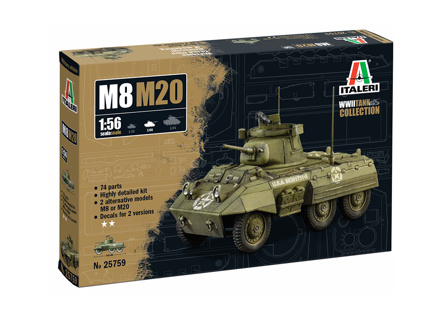M8/M20
Item No. W25759
At the beginning of World War II, the U.S. Army had lightweight and lightly armed vehicles, called "scout cars," for advanced reconnaissance activities. Developed during the war, the M-8 Greyhound armoured car, characterized by increased protection and heavier armament, represented a turning point f
Description
At the beginning of World War II, the U.S. Army had lightweight and lightly armed vehicles, called "scout cars," for advanced reconnaissance activities. Developed during the war, the M-8 Greyhound armoured car, characterized by increased protection and heavier armament, represented a turning point for the American army.
The vehicle provided greater operational flexibility and could be more effectively used to support ground troops thanks to the 37mm cannon installed in the turret. First used on the Italian front, from Monte Cassino to Anzio, it later participated in the D-Day operations in June 1944. Although the terrain in Normandy proved challenging and demanding during the initial phases of the operation, later on the M-8 was particularly appreciated for its speed of movement and versatility in deployment. The M-20 version was developed from the M8 version for Military Police duties and command vehicle roles.
The vehicle provided greater operational flexibility and could be more effectively used to support ground troops thanks to the 37mm cannon installed in the turret. First used on the Italian front, from Monte Cassino to Anzio, it later participated in the D-Day operations in June 1944. Although the terrain in Normandy proved challenging and demanding during the initial phases of the operation, later on the M-8 was particularly appreciated for its speed of movement and versatility in deployment. The M-20 version was developed from the M8 version for Military Police duties and command vehicle roles.
M8/M20
Item No. W25759
At the beginning of World War II, the U.S. Army had lightweight and lightly armed vehicles, called "scout cars," for advanced reconnaissance activities. Developed during the war, the M-8 Greyhound armoured car, characterized by increased protection and heavier armament, represented a turning point f
Description
At the beginning of World War II, the U.S. Army had lightweight and lightly armed vehicles, called "scout cars," for advanced reconnaissance activities. Developed during the war, the M-8 Greyhound armoured car, characterized by increased protection and heavier armament, represented a turning point for the American army.
The vehicle provided greater operational flexibility and could be more effectively used to support ground troops thanks to the 37mm cannon installed in the turret. First used on the Italian front, from Monte Cassino to Anzio, it later participated in the D-Day operations in June 1944. Although the terrain in Normandy proved challenging and demanding during the initial phases of the operation, later on the M-8 was particularly appreciated for its speed of movement and versatility in deployment. The M-20 version was developed from the M8 version for Military Police duties and command vehicle roles.
The vehicle provided greater operational flexibility and could be more effectively used to support ground troops thanks to the 37mm cannon installed in the turret. First used on the Italian front, from Monte Cassino to Anzio, it later participated in the D-Day operations in June 1944. Although the terrain in Normandy proved challenging and demanding during the initial phases of the operation, later on the M-8 was particularly appreciated for its speed of movement and versatility in deployment. The M-20 version was developed from the M8 version for Military Police duties and command vehicle roles.

